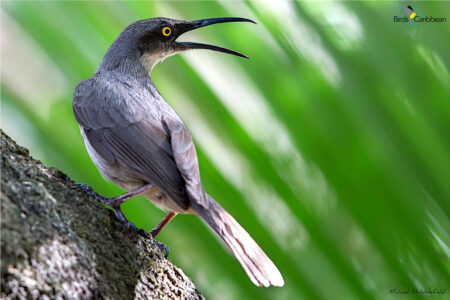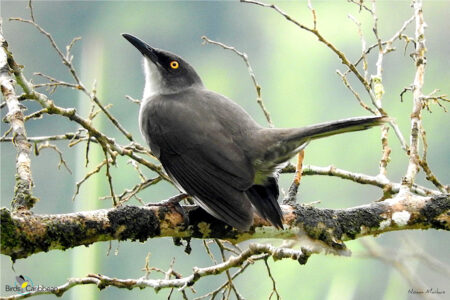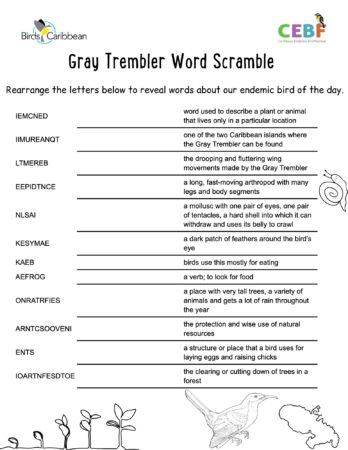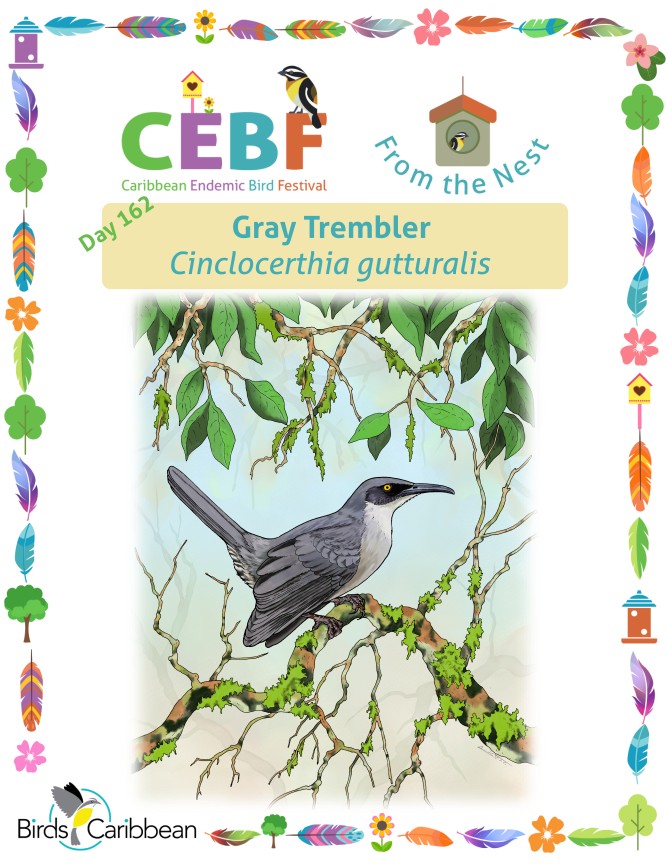Celebrate the Caribbean Endemic Bird Festival (CEBF) with us! Our theme in 2025 is “Shared Spaces: Creating Bird-friendly Cities and Communities”—highlighting the crucial role bird-friendly cities and communities can have in addressing the decline in bird populations caused by threats like habitat loss, predation, and climate change. Have fun learning about a new endemic bird every day. We have colouring pages, puzzles, activities, and more. Download for free and enjoy learning about and celebrating nature!
Endemic Bird of the Day: Gray Trembler
The Gray Trembler really knows how to put on a show! When it sings, its entire body trembles with excitement—its wings droop and quiver, and its tail pulses in a rhythmic shake. This bird’s got serious moves! While it sticks to one signature dance, its vocal performance is anything but predictable. One of its common songs is a series of quavering whistles that slide downward in pitch. Other times, it belts out elaborate warbles reminiscent of its cousin, the mockingbird—or switches to simpler chortling trills. It even has a raspy, buzzy call that sounds like it’s giving someone a good scolding!
If you want front-row seats to this performance, you’ll need to visit Martinique or St. Lucia–the only two places in the world where this endemic species lives. They’re year-round residents, and within these islands, they use a variety of habitats: lush lower montane rainforests, coastal dry forests, open woodlands, and even gardens. But don’t expect to find them in large numbers—they’re widespread but never abundant.
So, if you’re lucky enough to be in the right place, what should you look for besides the dancing? True to its name, the Gray Trembler is mostly gray, with a slightly darker face mask that frames a piercing yellow eye, rimmed in red. It sports a long tail, long wings, and an impressively long, curved bill. You’ll often spot it close to the forest floor, using that strong bill to flip over leaves—sometimes launching them high into the air—or to probe into crevices between vines and tree trunks. What’s on the menu? Pretty much anything it can catch: snails, beetles, small lizards, frogs, even centipedes!
We still have more to learn about the Gray Trembler’s breeding behavior, but here’s what we do know: they breed during the rainy season (April to August), laying striking greenish-blue eggs, usually laid in clutches of two to three. Their nests are open cups, built from dead leaves and twigs, placed high up in medium-sized trees. Both parents share the job of feeding the nestlings, offering a varied diet that includes fruit. And one more fun fact—they seem curious about technology—Gray Tremblers have been caught on video pecking at the cameras used to monitor their nests!
While the Gray Trembler isn’t globally threatened, it’s considered range-restricted, since it’s found only on two islands. That makes it especially vulnerable to environmental changes. One major concern is the degradation and destruction of the forests it calls home. Protecting these forests is essential, not just for the trembler, but for many other unique species that live alongside it.
What can you do? Start small: reduce waste, recycle, and avoid products that contribute to deforestation. You can also support local environmental groups, join tree-planting efforts, and share the story of the Gray Trembler and the importance of its forest habitats. Every action—big or small—helps. Learn more about this species, including its range, photos, and calls here. Great news! If you’re in the Caribbean, thanks to BirdsCaribbean, you have free access to Birds of the World and you can find out even more in the full species account of this bird!
Thanks to Arnaldo Toledo for the illustration and Dr Jennifer Mortensen for the text!
Colour in the Gray Trembler
Download our West Indies Endemic Bird colouring page. Use the photos below as your guide, or you can look up pictures of the bird online or in a bird field guide if you have one. Share your coloured-in page with us by posting it online and tagging us @BirdsCaribbean #CEBFfromthenest
Listen to the song of the Gray Trembler
The song of the Gray Trembler a slow jumble of wavering rich whistles. They also have a raspy, harsh sounding alarm call.
Puzzle of the Day
Click on the image below to do the puzzle. You can make the puzzle as easy or as hard as you like – for example, 6, 8, or 12 pieces for young children, all the way up to 1,024 pieces for those that are up for a challenge!



Activity of the Day
 FOR KIDS : Use the information above and the clues on the sheet to untangle our our word scramble – all about the Gray Trembler. You’ll need to know about where it lives, what it eats, and how it behaves. You can find all the answers here.
FOR KIDS : Use the information above and the clues on the sheet to untangle our our word scramble – all about the Gray Trembler. You’ll need to know about where it lives, what it eats, and how it behaves. You can find all the answers here.
FOR KIDS AND ADULTS : Enjoy this video of a Gray Trembler in the wild!


